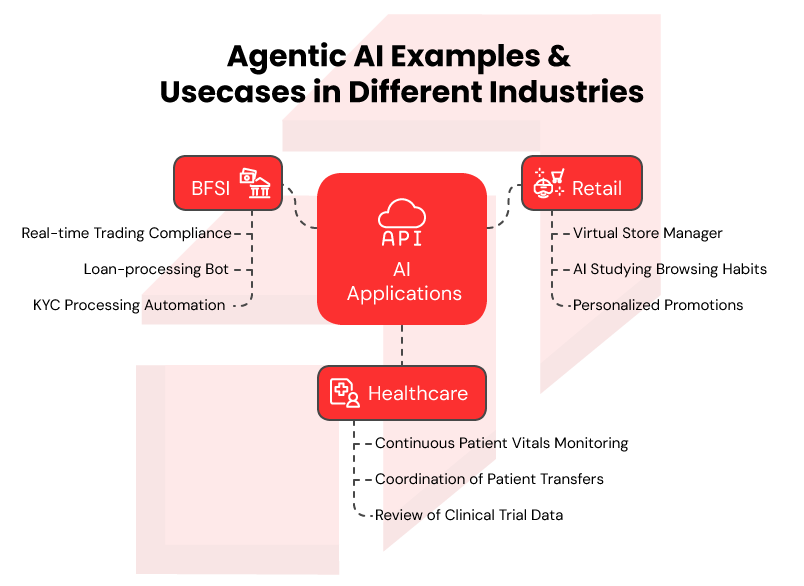Why You Should Care About Agentic AI . Let’s be honest, generative AI is already making waves. From creating art to writing code, these models have left many business leaders awestruck. Here’s the thing; this is just the start. A lot of companies are still figuring out tools like ChatGPT and AI copilots. Meanwhile, a different kind of AI is making its entrance. It’s not loud, but it’s making waves. It’s called Agentic AI. Instead of just producing content, it gets things done.
If you run a business manage a team, or plan to explore AI’s role in your work, you should pay attention to this breakthrough. Generative AI may help boost efficiency, but Agentic AI reshapes workflows. It transforms how work gets done. It removes routine decisions from human hands and allows processes to run, adapting and getting better as they go.
What is Agentic AI
Agentic AI is a form of artificial intelligence that can independently plan, decide, and act in pursuit of a goal. Unlike traditional automation that follows scripts or generative models that wait for prompts, agentic AI takes initiative.
Picture this: you tell an agentic AI to “optimize your inventory.” Instead of handing you a report, it analyzes stock levels, predicts future demand, finds supplier deals, initiates restocking, and even schedules deliveries; all without human nudging.
It acts like an intelligent “agent”, equipped with a goal and the tools to pursue it.
Agentic AI vs Generative AI: What’s the Difference?
How exactly is agentic AI different from what you already know as generative AI?
Here’s a quick comparison:
| Feature | Generative AI | Agentic AI |
| Primary Role | Content generation | Goal-driven action |
| Autonomy | Responds to prompts | Acts without direct input |
| Functionality | Writes, summarizes, edits | Plans, executes, adapts |
| Examples | ChatGPT, DALL-E | OpenAI Agents |
| Enterprise Use | Speeds up tasks | Automates full processes |
Agentic AI Examples & Usecases in Different Industries

BFSI: From Chatbots to Intelligent Advisors
In the BFSI sector, agentic AI is a dream come true. Traditional automation here has always been about cutting costs and improving compliance. But agentic AI takes it several steps further.
An AI that monitors trading compliance in real-time, detects anomalies in market behaviour, and sends actionable alerts, before the regulator even knocks. Or a loan-processing bot that doesn’t just score applications but requests documents, cross-verifies data, approves within policy, and alerts credit officers about edge cases.
Key uses include:
- KYC processing automation with dynamic document verification.
- Underwriting decisions based on real-time credit behaviour.
- Insurance claim automation that handles filing, validation, and settlement without human input.
Retail: Personalized Shopping Meets Self-Running Operations
Retailers thrive on personalization, efficiency, and customer loyalty. Agentic AI helps achieve all three, at scale.
Think of a virtual store manager that tracks inventory live, forecasts demand using weather or events, restocks, and delivers promotions, all without needing people to do it. This same AI studies browsing habits, shares unique discount codes, and starts retention plans when it notices an important customer might leave.
Some retail-specific use cases:
- Personalized promotions based on behaviour, past purchases, and inventory cycles.
- Dynamic pricing adjustments in real time using market demand and competitor activity.
- Omnichannel order fulfilment decisions based on logistics, cost, and customer preferences.
Healthcare: AI That Does More Than Recommend
The healthcare industry has always been a prime candidate for AI transformation. But now, with agentic AI, it’s moving from recommendations to real, autonomous action. Unlike traditional systems that rely on human inputs for every step, agentic AI can streamline complex workflows end-to-end, enhancing both patient care and operational efficiency.
In hospitals, clinics and diagnostics, agentic AI can:
- Monitor patient vitals continuously via IoT devices, analyze deviations, and alert healthcare professionals automatically.
- Coordinate patient transfers and handle bed availability across departments.
- Streamline discharge planning to include pharmacy tasks scheduling follow-up visits, and sharing after-care instructions.
- Use AI to review tons of clinical trial data, identify trends, recommend actions, and create draft reports.
- For radiology, an agent can analyze images, compare with historical cases, and recommend diagnostics pathways, reducing turnaround time.
How Agentic AI Works
So how does this all come together? What’s really going on behind the scenes when an agentic AI acts?
At the heart of it are three primary layers:
Core Technologies Powering Agentic AI
- LLMs (Large Language Models): These are the brains that understand natural language, interpret context, and generate relevant responses. But more importantly, in agentic AI, LLMs go beyond talking, they help agents’ reason and make decisions.
- Planning Algorithms: These give agents the ability to set goals, break them down into sub-tasks, evaluate options, and decide what to do next.
- Tool Use (Actuation Layer): This is what truly enables autonomy. Agentic AIs don’t live in a vacuum.
Frameworks Behind the Magic
The agentic AI ecosystem is evolving fast, and a lot of the innovation is happening on the backs of open frameworks and cloud tools. Some of the most popular and capable frameworks powering agentic AI include:
- LangChain: A framework that helps you build context-aware, tool-using AI agents using language models.
- OpenAI Agents: Offers customizable agents with memory, planning, and tool use—all powered by GPT.
- AutoGen, CrewAI, and BabyAGI: Other experimental frameworks focusing on agent collaboration and recursive task execution.
Key Considerations Before Adoption in the Business
Agentic AI might sound like the perfect tech upgrade—but let’s not forget, it comes with its own set of challenges. Before diving in, enterprises need to ask themselves the right questions and align their teams for success.
Autonomy vs Control
How much autonomy are you comfortable giving an AI agent? While it’s tempting to automate everything, in regulated or mission-critical sectors, some level of human oversight is not just advisable, it is mandatory.
Organizations need to design “guardrails” to prevent rogue behaviours. These can include:
- Defined decision thresholds
- Audit logs for every action taken.
- Multi-agent validation for critical decisions.
Balancing trust and oversight are key pillars of responsible adoption.
Data Privacy, Ethics, and Security
Autonomous agents often need deep access to your internal data; financial records, customer profiles, system APIs. That makes them a huge privacy and security risk if not properly secured.
Before going live with agentic AI, ensure:
- Role-based access control is enforced.
- Data is anonymized where needed.
- Agents are sandboxed to prevent unauthorized actions.
- You have audit trails and real-time monitoring.
There’s also the ethical angle. Will customers feel comfortable interacting with a fully autonomous AI? Are you disclosing enough about its use? Transparency builds trust.
Cost and Infrastructure Readiness
Agentic AI doesn’t just work out of the box. You’ll need:
- A mature cloud infrastructure (often hybrid or multi-cloud).
- Integration readiness across APIs, CRMs, ERPs, etc.
- The right talent mix; AI engineers, MLOps, data architects, and cloud specialists.
How Enterprises Can Get Started
You’ve seen the potential of agentic AI. But here’s the real question: How do you get started without feeling lost? The key is to start small and with purpose, not to dive in headfirst.
Below is a simple plan to help companies take their first steps into agentic AI with clarity.
Starting Small With Pilot Projects
Picking a single process that is both impactful and safe to tackle first. That might look like:
- Using AI to take care of basic customer support issues.
- Managing IT desk tasks like resetting passwords.
- Matching up financial records across systems.
These tasks are ideal because they’re repetitive, measurable, and well-defined. Once you’ve proven success with one or two agents, it becomes easier to scale across departments.
Choosing the Right Tools and Partners
Here’s where things get real: the tools and tech stack you choose can make or break your efforts. You’ll need to evaluate:
- Agent frameworks
- Cloud providers
- Orchestration tools
- Security layers and observability stacks
But you don’t need to do this alone.
Strategic partners like Rapyder can help assess your environment, recommend the right stack, and fast-track implementation. Their cloud-native approach ensures that agentic AI is not only powerful but also sustainable, scalable, and compliant with enterprise standards.
Rapyder’s Role in the Journey
Rapyder is more than just a cloud services company, it’s your agentic AI transformation partner. From strategy to execution, we bring the tech, talent, and cloud infrastructure that make autonomous intelligence a reality.
From AI Strategy to Execution
Rapyder works with enterprises to build custom roadmaps that align AI capabilities with business goals. Whether it’s cloud migration, app modernization, or AI-powered automation, Rapyder ensures your AI agents are not just functional; but mission-ready.
Our team handles:
- Discovery & consulting to identify pilot opportunities.
- Custom agent development using LLMs and orchestration tools.
- Cloud-native deployment with governance and monitoring baked in.
Enabling Secure, Scalable Agentic AI
Security is non-negotiable. With Rapyder, you get:
- End-to-end encryption
- IAM and role-based agent permissions
- Real-time observability and alerts
- Secure API integrations
Whether it’s BFSI, healthcare, or retail, Rapyder ensures compliance with industry regulations and internal IT standards.
Why Rapyder’s Cloud Expertise Sets us Apart
What really makes Rapyder different is its deep bench of cloud-native skills. They help you:
- Orchestrate multi-agent workflows
- Build vectorized knowledge bases for memory-rich agents
- Optimize cost-performance with serverless AI architectures
- Automate full pipelines from dev to prod
With Rapyder, agentic AI isn’t just an innovation experiment, it becomes a core part of your digital transformation strategy.
Conclusion: The Future Is Autonomous
If generative AI was the warm-up act, agentic AI is the main event. We’re no longer talking about AI as a tool that helps you create content or summarize reports. We’re talking about digital agents that plan, execute, adapt, and deliver business value; autonomously.
Partner with experts. Start small. Think big. Because the future of automation isn’t just smart; it’s agentic.







